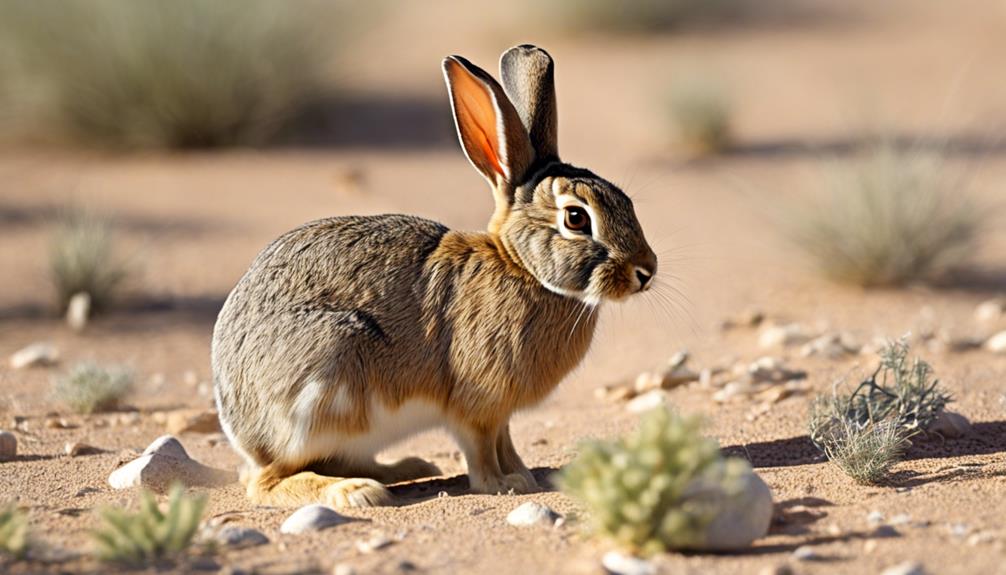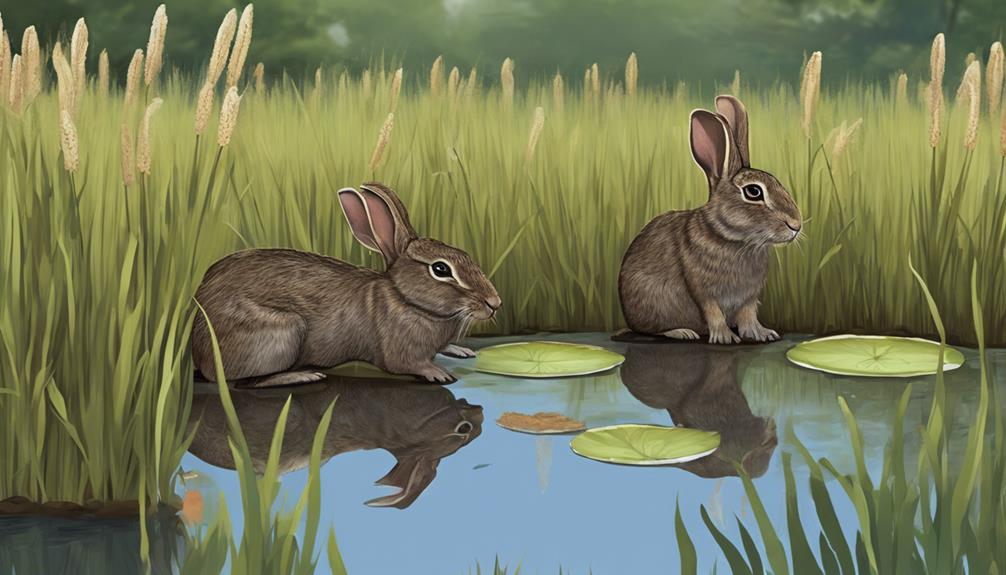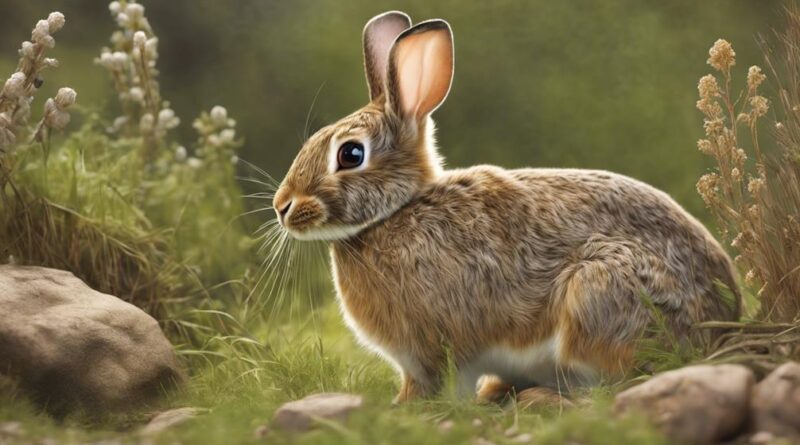Exploring 10 Wild Rabbit Species and Their Habitats
Explore the Arctic Hare's icy landscapes and the Snowshoe Hare's forest domains, both built for chilly survival. Witness the Pygmy Rabbit's burrow expertise in arid lands and the Brush Rabbit's grace in western North America. Discover the European Rabbit's complex warrens and the Desert Cottontail's agile escapes in deserts. See the Swamp Rabbit's watery habitats and the Marsh Rabbit's underwater skills along coastlines. Uncover the Amami Rabbit's forest conservation and the New England Cottontail's crucial role in maintaining biodiversity. Each species thrives in diverse habitats with unique adaptations.
Arctic Hare Habitats
Inhabiting the vast, snow-covered landscapes of the Arctic region, Arctic hares are adapted to thrive in extreme cold environments. These hares have evolved remarkable tundra adaptations to survive in the harsh conditions of the Arctic. Their thick fur coat not only provides insulation but also serves as camouflage against Arctic predators such as wolves, foxes, and birds of prey. Arctic hares are known for their exceptional speed, reaching up to 40 miles per hour, allowing them to swiftly evade predators across the icy terrain.
Climate change impacts have started to affect Arctic hare behavior and survival. As temperatures rise, the Arctic landscape is changing rapidly, leading to alterations in vegetation patterns and food availability for these hares. This shift forces Arctic hares to adapt their foraging habits and migration patterns. Additionally, the decrease in snow cover due to warmer temperatures exposes Arctic hares to increased predation as their once reliable camouflage becomes less effective.
Despite these challenges, Arctic hares continue to display resilience in the face of changing environmental conditions. Their ability to adjust to new circumstances and their unique adaptations make them a fascinating species to study in the dynamic Arctic ecosystem.
Pygmy Rabbit Habitats
With their own unique set of habitat requirements, Pygmy rabbits can be found in a variety of locations distinct from the Arctic hares' icy domain. These tiny rabbits, measuring only about 9-12 inches in length, inhabit arid landscapes such as sagebrush steppe and desert shrublands across the western United States.
Pygmy rabbits are known for their excellent burrow construction skills, using their small size and strong claws to dig intricate networks of burrows in sandy or loamy soils. These burrows provide essential shelter from predators like coyotes, foxes, and birds of prey, allowing the pygmy rabbits to evade danger efficiently.
When it comes to foraging behavior, pygmy rabbits are herbivores that primarily feed on sagebrush, grasses, and other vegetation found in their arid habitats. They play a crucial role in shaping their ecosystem by controlling plant growth through their feeding habits.
Despite their small size, pygmy rabbits exhibit complex social interactions within their communities. They're known to be relatively solitary creatures, but during the breeding season, males establish territories and compete for females. This behavior contributes to the genetic diversity and overall survival of the species.
European Rabbit Habitats
Nestled within diverse environments across Europe, European rabbits create intricate warrens that serve as their shelter and breeding grounds. These warrens aren't just simple burrows; they're complex systems with multiple entrances and exits, providing escape routes for predator evasion. The European rabbit demonstrates exceptional burrow construction skills, with some warrens extending several meters underground and containing separate chambers for nesting and sleeping.
When it comes to foraging behavior, European rabbits are primarily crepuscular, meaning they're most active during dawn and dusk. They've a diverse diet, consisting of grasses, herbs, and even the occasional vegetable or fruit. Their foraging patterns aren't only influenced by food availability but also by social interactions within their colony.
European rabbits are social animals, often living in large groups where hierarchies are established through displays of dominance and submission. These social interactions play a vital role in their survival, as they work together to alert each other of potential dangers from predators.
Snowshoe Hare Habitats
Snowshoe hares, known for their distinctive large hind feet that help them navigate through snow-covered terrain, thrive in diverse habitats ranging from boreal forests to alpine meadows. These habitats provide the perfect environment for snowshoe hares to exhibit their remarkable adaptations and behaviors.
- Winter Camouflage: Snowshoe hares have evolved to change the color of their fur from brown to white during the winter months. This transformation helps them blend seamlessly into the snow-covered landscapes, providing them with effective camouflage against predators such as lynx and owls.
- Snowfall Impact: The amount of snowfall in a particular season can significantly impact snowshoe hares. Heavy snowfall can make it challenging for them to find food and navigate their habitats, leading to decreased survival rates. In contrast, milder winters with less snow can benefit snowshoe hares by providing easier access to food sources.
- Seasonal Migration: Snowshoe hares exhibit seasonal migration patterns in response to changing environmental conditions. During the winter, they may move to lower elevations or areas with less snow to improve their chances of survival. In contrast, in the summer months, they may migrate back to higher elevations where food sources are more abundant.
Brush Rabbit Habitats
The Brush Rabbit, a small and elusive species native to western North America, thrives in a variety of habitats ranging from chaparral and grasslands to riparian areas. These rabbits exhibit interesting burrowing behavior, creating intricate networks of burrows within dense vegetation to seek shelter from predators and harsh weather conditions. Their diet consists mainly of grasses, herbs, and the occasional shrub, showcasing their adaptability to different food sources available in their habitats.
Predators play a significant role in the population dynamics of Brush Rabbits. Natural predators such as coyotes, foxes, and birds of prey keep their numbers in check, prompting these rabbits to remain vigilant and rely on their excellent camouflage and quick reflexes to evade danger. Human activities and habitat destruction also pose a threat to Brush Rabbit populations, leading to a decline in their numbers in certain regions.
Understanding the interplay between burrowing behavior, diet, predators, and population dynamics is crucial for the conservation of Brush Rabbits. By preserving their diverse habitats and implementing measures to minimize human-wildlife conflicts, we can ensure the continued existence of these fascinating wild rabbits in the diverse landscapes they call home.
Swamp Rabbit Habitats
In the lush and watery environments of wetlands and swamps across North America, a distinct rabbit species finds its habitat – the Swamp Rabbit. These rabbits have adapted remarkably to thrive in such unique ecosystems, showcasing fascinating behaviors and physical traits.
Wetland ecosystems: Swamp Rabbits are expert swimmers, using their webbed feet to navigate through the marshy waters where they reside. Their fur is water-resistant, keeping them dry and warm even in the dampest of environments. These rabbits also have a keen sense of smell, which helps them locate food and detect predators in the dense vegetation of the wetlands.
Rabbit adaptations: To camouflage themselves from predators like alligators and birds of prey, Swamp Rabbits have evolved a coat that matches the colors of the surrounding reeds and cattails. Their ability to dart quickly through the water and hide in underwater burrows further enhances their survival in these challenging habitats.
Conservation efforts, habitat restoration: Due to habitat loss caused by human activities such as wetland drainage and development, conservation efforts are crucial to protect Swamp Rabbit populations. Organizations focus on restoring wetlands and creating wildlife corridors to ensure these unique rabbits have a safe and sustainable habitat for generations to come.
Desert Cottontail Habitats

Amidst the diverse habitats of North America's wild rabbit species, the Desert Cottontail finds its home in the arid landscapes of deserts and scrublands. These rabbits are well-adapted to the harsh conditions of their environment, showcasing fascinating behaviors for survival.
Burrow excavation is a key aspect of the Desert Cottontail's habitat. They dig extensive burrow systems in the sandy soil to escape the scorching desert heat and evade predators. These burrows not only provide shelter but also aid in temperature regulation, allowing the rabbits to stay cool during the day and warm at night.
In terms of foraging behavior, Desert Cottontails are opportunistic feeders, consuming a variety of vegetation such as grasses, cacti, and shrubs. Their keen sense of smell helps them locate food in the sparse desert landscape. This foraging behavior is crucial for their survival in an environment where food sources can be scarce.
Predator avoidance is another skill that Desert Cottontails have honed. They rely on their speed and agility to escape from predators like snakes, birds of prey, and coyotes. Their ability to quickly dart into the safety of their burrows also plays a vital role in evading danger.
Amami Rabbit Habitats
Nestled within the lush forests of Japan's Amami Islands, the Amami Rabbit thrives in its unique habitat. These rabbits are fascinating creatures with remarkable adaptations that help them survive in this specific environment.
Key Points:
- Amami Rabbit Conservation Efforts
The Amami Rabbit faces threats from habitat loss and invasive species. Conservation efforts are crucial to protect these rabbits. Organizations work tirelessly to preserve the forests where these rabbits live, implementing measures to ensure their long-term survival.
- Unique Adaptations of Amami Rabbits
These rabbits have evolved to be excellent climbers, using their strong hind legs and sharp claws to navigate the dense vegetation of the Amami Islands. Their keen sense of smell helps them locate food in the forest, which mainly consists of leaves, bark, and twigs. Additionally, their fur coloration provides excellent camouflage, allowing them to blend seamlessly into their surroundings and avoid predators.
- Preservation of Habitat
The unique ecosystem of the Amami Islands is crucial for the survival of the Amami Rabbit. By protecting the forests and maintaining biodiversity, not only are the rabbits safeguarded, but the entire habitat benefits. Efforts to control invasive species and promote sustainable land use are essential components of ensuring the long-term viability of this species.
Marsh Rabbit Habitats

Among the diverse habitats that support various rabbit species, the marshlands provide a unique and essential environment for the Marsh Rabbit's survival and adaptation. These wetlands are crucial for wetland conservation and play a significant role in maintaining healthy rabbit populations. The Marsh Rabbit, known for its smaller size and strong swimming abilities, thrives in the marshes of the southeastern United States, particularly along the Gulf and Atlantic coastlines.
Human impact on marshlands has posed challenges to the survival of Marsh Rabbits. Wetland conservation efforts are essential in safeguarding these habitats and the rabbit populations that depend on them. Human activities such as habitat destruction, pollution, and urbanization have threatened the Marsh Rabbit's natural habitat. It's crucial to address these issues to ensure the continued survival of this unique rabbit species.
The Marsh Rabbit's ability to navigate through marshy terrains and swim across water bodies has allowed it to adapt to the challenges posed by its habitat. These rabbits build their nests in dense vegetation near water, providing them with both shelter and easy access to their aquatic food sources. Their survival is intricately linked to the health of the marshlands, making wetland conservation efforts vital for preserving not only the Marsh Rabbit but also the entire ecosystem that depends on these unique habitats.
New England Cottontail Habitats
New England Cottontails primarily inhabit dense shrublands and young forests in the northeastern regions of the United States. These habitats provide the necessary cover and resources for these elusive rabbits to thrive. Here's a closer look at their preferred habitats:
- Forest Undergrowth: New England Cottontails are often found nestled within the thick undergrowth of forests. They rely on this dense vegetation for protection from predators and as a source of food. The undergrowth also serves as a shelter for their young, keeping them safe from harm.
- Biodiversity: The presence of New England Cottontails in these habitats is crucial for maintaining biodiversity. By foraging on a variety of plants and helping disperse seeds, these rabbits play a vital role in the ecosystem. Their presence contributes to the overall health and balance of the forest ecosystem.
- Conservation Efforts, Habitat Restoration: Due to habitat loss and fragmentation, the population of New England Cottontails has been declining. Conservation efforts are underway to restore their habitats by planting native shrubs and trees, creating corridors for safe movement, and managing vegetation to mimic natural conditions. These initiatives aim to ensure the long-term survival of this species in the wild.
Understanding the specific habitat requirements of New England Cottontails is essential for supporting their conservation and preserving the biodiversity of the northeastern forests.
Frequently Asked Questions
How Do These Rabbit Species Adapt to Extreme Weather Conditions?
In extreme weather conditions, wild rabbit species adapt by constructing intricate burrows for shelter and regulating body temperature through thermoregulation.
When faced with food scarcity, they exhibit strategic migration patterns to find resources.
These behaviors showcase their resilience and ability to thrive in challenging environments.
What Predators Pose a Threat to These Wild Rabbits?
Predators play a crucial role in maintaining ecological balance by regulating prey populations. The dynamic between predators and wild rabbits is essential for the overall health of the ecosystem. Various predators, such as foxes, hawks, and snakes, pose a threat to these rabbits, driving them to adapt and evolve defense mechanisms.
Understanding predator-prey dynamics is key to comprehending the intricate web of life in the wild.
Are There Any Conservation Efforts in Place for These Species?
Conservation strategies aim to protect wild rabbit species.
Population monitoring helps track trends and guide interventions.
Habitat restoration enhances their living spaces, aiding in their survival.
Community engagement raises awareness and involvement in safeguarding their habitats.
These efforts play crucial roles in preserving wild rabbit populations for future generations.
Do These Rabbits Have Any Unique Physical Characteristics for Survival?
Rabbits possess unique adaptations that aid in their survival. Their physical traits, such as keen senses and speed, help them navigate environmental challenges. These creatures rely on their camouflage abilities and agile movements to evade predators.
How Do Human Activities Impact the Habitats of These Wild Rabbit Species?
Human activities significantly impact wild rabbit habitats. Urban development and deforestation destroy their natural homes, forcing them to adapt or perish.
Climate change and pollution further exacerbate these challenges, affecting their food sources and overall well-being. As humans alter the environment, wild rabbit populations face increased risks and struggle to find suitable areas to thrive.
It's crucial to address these issues to ensure the survival of these fascinating creatures.
Conclusion
As you've explored the diverse habitats of 10 wild rabbit species, you've witnessed the Arctic Hare's icy tundra, the Pygmy Rabbit's sagebrush plains, and the European Rabbit's grassy meadows.
From the Snowshoe Hare's boreal forests to the Amami Rabbit's subtropical islands, each habitat plays a crucial role in supporting these unique species.
By understanding and protecting these environments, we can ensure the continued survival of these fascinating creatures in the wild.
